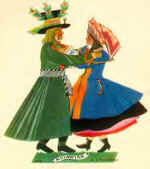|
Dance and Music
|
|
 |
Poland has a long tradition of folk music and dance. Although the country was heavily affected by the large-scale migration to urban areas that took place following World War II, Poland’s folk traditions still exist today, and are displayed for audiences by the well-known Mazowsze ensembles. The best-known Polish composer is Frédéric Chopin (Polish Fryderyk Chopin), a pianist of the romantic school of music who lived during the first half of the 19th century. Chopin, who died at a young age, spent much of his life in France. However, he remained deeply loyal to Poland and many of his compositions were based on traditional Polish folk music and dances, such as the mazurka and the polonaise. The early 20th century composer Karol Szymanowski is regarded as the most important figure in Polish music after Chopin. Szymanowski is known for bringing together elements of Poland’s folk tradition and European musical styles. After World War II ended in 1945, a school of music emphasizing avant-garde elements developed in Poland. Krzysztof Penderecki was a well-known composer of this school. Important Polish musicians include the harpsichordist Wanda Landowska and the pianist Ignace Jan Paderewski. |
|
|
Folk music in Poland varies widely from region to region and is closely associated with festivals and celebrations. Weddings, Christmas commemorations, and harvest festivals are all occasions for processions and songs. In most rural areas musicians are amateurs, picking up their instruments only after putting in a full day’s work in the fields. In this example, a group of rural musicians from the Rzeszów region of southeastern Poland play a polka on two violins, a clarinet, a contrabass, and a cymbaly (a hammer dulcimer that is played throughout Poland). |